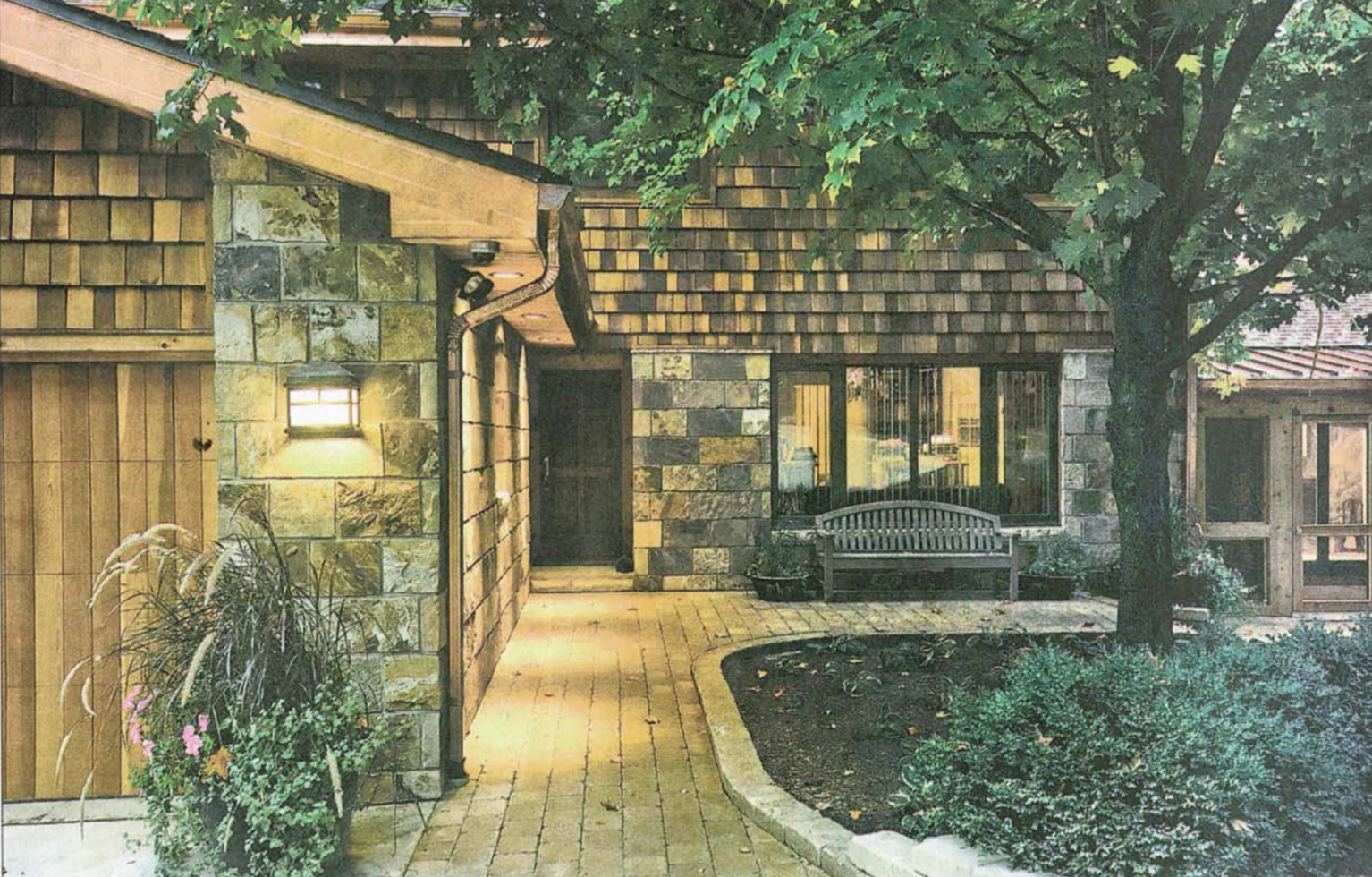
28 Dec Green Sophistication | Peoria Couple Redefines Home by Being Environmentally Conscious
NEWSPAPER: PEORIA JOURNAL STAR
DATE: 12/28/2008
AUTHOR: CLARE HOWARD
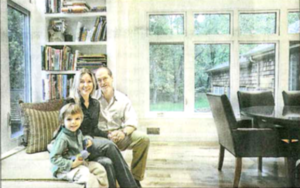
Les and Melissa Cohen sit in the family room, where they spend time with their son, Julian. Where large windows once meant sacrificing some warmth, the Cohens opted for technologically-advanced triple-paned windows from Sweden.
EDITOR’S NOTE: Green Homes of Central Illinois is an ongoing series that will feature both new and old construction and will explore the nuts and bolts of green building and the green philosophy.
Les Cohen has channeled lifetime of environmentalism, art and science into the green renovation of his rural Peoria home. The result is thoughtful and stunning.
The house projects a sense of balance, connected with its physical and spiritual environment.
The project has given Cohen an intense education in ventilation, mold, toxic building materials, water purification systems and more. He’s writ- ten a virtual doctoral dissertation triangulating foam, fiberglass and recycled blue jean insulations.
After working on his renovation for nearly 14 years, Cohen has intensified his concern for the environment and extended the application of his scholarship into his professional life.
He and his wife Melissa looked at more than 30 houses in 1995 before reluctantly concluding they were not going to find their ideal home.
“Whenever we tour new houses, I notice that new house smell. I used to think that’s what new houses smell like. But those smells are chemicals in the building. A green house has no smell,” Melissa Cohen said.
Ultimately, the couple purchased a home built in the 1970s. More than the house, they loved the setting with views of the rising moon, setting sun and windows that look out at acres of woodland.
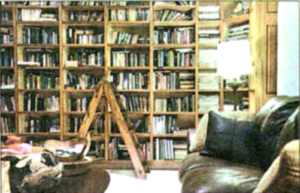
The Cohen’s designed their library with 8-foot-tall cherry and birch shelving to house their collection dominated by art and environmental books.
Over the years, the couple worked with builders, architects and craftsmen. Cohen called company presidents and scientists seeking more information about building materials and methods. His goal was not only to use environmentally-sustainable materials but to create a healthy, chemical-free, well-ventilated environment for his family.
“Green doesn’t necessarily have to cost more, but it does require more thoughtful planning and research,” said Cohen, president of Cohen Development Co.
Researching nontoxic insulation on the Internet, he discovered Air Krete foam insulation, a product former vice president Al Gore has used in his home. Cohen spoke with Keene Christopher, the inventor and CEO of Air Krete, which manufactures the product. Cohen contracted with Mike Schmidt of Schmidt Exteriors in Carol Stream to blow the insulation into the walls of his home.
“This product outperforms other insulation, is completely fireproof, mold resistant, nontoxic and sound attenuating,” Cohen said.
Schmidt said, “This will cut fuel consumption by 30 percent. People comment on how quiet their homes become.
“This is our first job in the Peoria area, but we’ve done work throughout the Chicago area, Minneapolis, Milwaukee, Indianapolis and Cedar Falls, Iowa. It’s an easy decision to choose Air Krete. We’ve done all the old homes on the North Shore.”
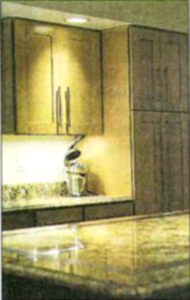
Les Cohen’s extensive research allayed any fears about reported release of radon gas by granite countertops.
One house Schmidt insulated just outside of Chicago with Air Krete had a fuel savings of 58 percent.
“We get more letters about Air Krete than any other thing we do,” he said.
The fire wall created by the insulation was an important factor in Cohen’s decision to remove all the exterior sheathing from his house as well as all the old fiberglass insulation and have Air Krete blown in. He and Schmidt used a 3,700-degree plumber’s torch to show heat that melts a penny has no effect on Air Krete insulation.
“This is cement and sea water. It’s not going to burn,” Cohen said, noting that if a building insulated with Air Krete is demolished, the insulation turns to sand and does not pollute surrounding ground.
Melissa Cohen’s favorite insulation is Ultra Touch by Bonded Logic, a product made from recycled blue jeans. This insulation is the best for suppressing sound, she con- tends. Her husband can crank up the volume in their basement home theater and nothing is heard in the rest of the house.
A self-described “child of the ‘70s,” Cohen graduated from Bowdoin College in Maine with a degree in environmental science and political science. He studied at Oxford University in England and worked in California before returning to Peoria to join the family firm developing and managing shopping centers.
His professional retail projects include environmental modifications like permeable paving and green roof technology. His personal residence even more closely reflects his lifelong passions.
He has planted more than 120 evergreens on his property, mostly white pines and hemlocks. The deciduous trees planted on the property include birch, sugar maple, red oak, service berry and swamp maples.
He designed a circular driveway with permeable pavers and planted herbs and strawberries between landscape boulders along the drive.
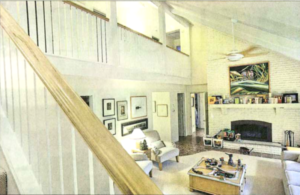
A ceiling fan spins in the living room of Les and Melissa Cohen’s rural Peoria home.
“We’ve used edible landscaping,” he said, pointing out fruit trees, herbs and blueberry bushes. He designed a fenced organic garden and used natural stone and cedar on the outside of the home.
Crushed stone paths wind from the house to the pool, barn and other outbuildings. Cohen calls one of the outbuildings a dojo, referring to the concept of “a place of searching for enlightenment.” His dojo serves as a study, studio, workshop and exercise facility.
The insulation value in the dojo roof is R-80 and the wall value is R-60. He has used environmentally- friendly paints, stains and wood sealants on the dojo, home and all other outbuildings.
After extensive research, he selected triple-paned H windows from Sweden with extruded metal trim on the outside and poplar wood trim on the inside.
Anew room off the kitchen is where family members spend the most time. Cohen’s wife can work on the computer while son Julian, 3, plays on the blonde birch floors. Windows place this room in the surrounding woodland.
“This window seat is where we read to Julian every night,” Cohen said. “There is a spirituality and emotionality here. It’s a perfect east exposure for watching the sun rise and the moon rise.”
Cohen said they bought the home for $165,000 in 1995 primarily be- cause of the wooded location.
A library in the home is lined with 8-foot tall cherry and birch shelving, and a good portion of the collection includes art, architecture and environmental books. The home has three screened porches designed to capitalize on air currents. All the screening is copper, a natural product Cohen has used extensively on the home’s exterior including fascia and downspouts.
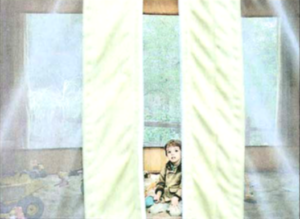
Julian Cohen pauses in his screened, sand-filled play area
“There is a good green market for recycled copper,” he said.
A gym in the lower level of the home has a cork floor with a maple overlay.
“In thinking about green, there are four levels to consider human health, ecological health, building system performance and building system longevity,” he said. “With home builders making tighter and tighter homes, you need to worry about how the home breathes.”
He has a system of air circulation that moves the air in each room every 20 minutes, providing for continuous fresh air exchange. He also has designed air circulation for under his exterior cedar shakes and under the roof.
“Old buildings in Europe are over 400 years old because they have air flow. You’ve got to provide for air circulation and vapor flows behind walls so moisture can dry out,” he said.
In the 1970s, environmentalism was at least partially defined in terms of less consumption, less comfort and an ascetic lifestyle.
“That’s not true anymore. Now we can look at environmental- ism as more luxurious and more comfortable. Research provides many alternatives. The goal is not to reduce our standard of living, but to develop alternatives,” Cohen said. “Problems with a house become opportunities to research. Ultimately, it is our moral responsibility to take construction to this next level.”
Cohen would like to see the value placed on economic growth recalibrated.
“We need to define growth as sustainable, not simply growth as development,” he said. “We can’t continue with that kind of thinking.”
